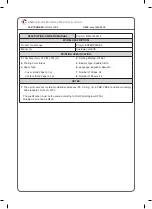
Instructions for Use
55
Cleaning and maintenance of ceramic-glass hob
fig. 1
fig. 2
fig. 3
fig. 4
fig. 5
Ceramic glass hob
should be cleaned only when
completely cooled down, preferably after each
use, otherwise even the slightest stains remaining
after cooking may burn into the hob surface with
each following use.
For regular maintenance of ceramic-glass hob
use special cleansing agents,
produced in such
way to create protective film upon the surface.
Before each use,
wipe the dust and other
particles from the hob - they may scratch the
surface (Fig. 1).
Caution:
use of steel wool, abrasive cleaning
sponges, and abrasive detergents can scratch
the surface of the hob. The surface may also be
damaged by the use of aggressive sprays and
inappropriate liquid chemicals (Fig.1 and 2).
Pattern marks
can be erased by the use of
aggressive cleansing agents or rough and
damaged cookware bottoms (Fig. 2).
Minor stains
are removed with moist soft cloth;
after that the surface should be wiped dry (Fig. 3).
Water stains
are removed with gentle vinegar
solution, but you must not wipe the frame with it
(certain models only), since it may lose its glow.
Never use any aggressive sprays or limestone
removers (Fig. 3).
Major stains
are removed with special ceramic-
glass cleansers. Follow strictly the manufacturer's
instructions.
Be careful to remove any remains of
cleansing agent from the hob surface,
otherwise they will be heated during the next
use and can damage the hob
(fig. 3).
Stubborn and burnt stains
are removed with
special ceramic-glass scraper. Be careful,
however, not to touch the hotplate surface with
the scraper handle (Fig. 4).
Handle the scraper with utmost care to avoid
injuries!
Sugar and sugar containing
food may
permanently damage the ceramic-glass hob
surface (Fig.5), so the remains of sugar and
sugar containing food must be scraped off from
the hob surface immediately, when the hotplates
are still hot (Fig. 4).
Discoloring of ceramic-glass hob
has no effect
whatsoever on its operation and stability. In most
cases, it appears as the consequence of burnt in
food remains, or as a result of dragging pots and
pans (especially aluminum or copper bottom
cookware) across the surface, and such
discoloring is rather hard to remove.
Note:
All described faults are mostly esthetical
and do not affect directly the operation of the
appliance. Remedy of such faults is not covered
by warranty.
Oven
Switch off the oven before cleaning!
The interior of the oven, as well as the
counterdoor and trays are enameled with
special
enamel
which has an extremely smooth and
glossy surface. This means that food doesn't
stick to it and cleaning is easy and simple. High
temperature an chemical resistance and its
mechanical strength make it last longer than the
classic enameled trays.
We recommend regular cleaning of the cold oven
and accessories.
Most of the stains can
easily
be removed with
mild environmentally friendly cleaning agents that
you usually use in your household (agents for



































